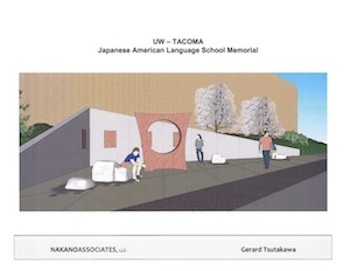Japanese Language School memorial to feature work of prominent sculptor
Gerard Tsutakawa has designed a 9-foot-tall bronze artwork to be featured along the campus's Prairie Line Trail.
What will the UW Tacoma and the Seattle Mariners have in common someday? Sculptures made by the same Pacific Northwest artist.
Gerard Tsutakawa, who created the iconic sculpture of a giant baseball mitt at the Mariners’ home, Safeco Field, has designed a piece for UW Tacoma’s planned memorial to the former Japanese Language School.
Discussion of the proposed artwork surfaced during a recent UW Tacoma presentation to the Tacoma City Council on the university’s latest plans for the memorial.
Mike Wark, UW Tacoma director of external relations, stressed the university is in the preliminary stages of a campaign to raise $600,000 for the memorial. During the council study session, he said he wanted to update council members since the memorial will tie in with the Prairie Line Trail and other community initiatives.
Plans call for a 9-foot-tall brass rectangular sculpture with a large cut-out circle, wide enough for people to sit on. The circle is a prominent design concept in Japanese art and a familiar element in Tsutakawa’s work. “The Mitt,” for instance, includes an abstract, circular opening that the Mariners’ website says appears to represent “a ball nestled in the leather, or a hole where a fastball burned through.”
The sculpture will be part of an outdoor plaza intended to recognize the historic Japanese Language School that once stood on the edge of the 46-acre campus.
Historic school falls into disrepair
Called “Nihon Go Gakko,” the school opened in 1911 to teach Japanese language and culture to Japanese American children, who attended class there after their public school classes ended for the day. The building also served as a community center until World War II, when Tacoma’s Japanese Americans were sent to internment camps.
The school once sat on the National Register of Historic Places, but fell into disrepair and was labeled a safety hazard by the City of Tacoma. In 1990, UW Tacoma purchased the wooden structure in 2004, but removed it after a consultant determined the structure was so decayed it couldn’t be restored with historical integrity.
The university plans to build the memorial near academic buildings as part of its Hood Corridor project . That’s a project to develop the old railroad corridor cutting through campus into park space that will link with the proposed Prairie Line Trail through Tacoma.
Design by prominent landscape architect

The triangular plaza will include a retaining wall set into the hillside, rock benches, Japanese black pine, flowering cherries and plaques commemorating the language school and its principal.
Seattle landscape architect Kenichi Nakano is designing the memorial. His firm, Nakano Associates, has created the landscape of many parks, trails, schools and other public installations. One of the firm’s most prominent projects was the 1995 renovation of the International Fountain at Seattle Center.
He also has a personal connection to the project. His mother, Yaeko Nakano, attended the language school.
The elder Nakano and other language school alumni serve on the memorial project’s advisory group. She spoke at the city council study session last week.
Alumni memories
“When we came back from the internment camp, we had nowhere to go to, and so we stayed at the Japanese school until I could find a home in Fife,” said Yaeko Nakano, 89. “So to me, it’s a very, very nostalgic place, and a wonderful place with lots of memories.”
Unlike most other Japanese language schools on the West Coast, the Tacoma school was not sponsored by a Buddhist temple or a Christian church, at the insistence of school founder and principal Masato Yamasaki, said Ted Tamaki, who attended the school as a child. Yamasaki wanted the school to stand on its own as a center for all Japanese American youth.
“Because of that it established a community togetherness, cohesiveness if you like, that brought all of the Japanese Americans together,” Tamaki, 85, told city council members. Students grew up feeling like they were family.
“I look at Yaeko over here, and I know exactly how old she is. She’s the same age as my sister Sue, maybe a year older. This goes for everybody.”
Among the school alumni are a heart surgeon, a federal judge and veterans who served with the U.S. Military Intelligence Service in World War II translating enemy documents and interrogating prisoners of war.
City council reaction
The university originally proposed to build the memorial at 17th and Market streets with a water feature, lights and $2.5 million budget, but the recession and death of one of the lead fundraisers prompted the university to propose a lower-cost project at a different location. Building the memorial among the campus buildings and as part of the new Prairie Trail Line, will also give it more visibility.
Council members expressed support for the new plans.
Council member Marty Campbell said the new design, buffered against a retaining wall, will make for a quieter, more contemplative place.
Campbell, who participated in some of the project’s early planning meetings years ago said, “I’m just glad to see it didn’t go away. ... I’ve been very impressed by this whole history behind it.”
Council member Jake Fey said he was looking through his family papers and learned about a relative who had been interned.
“It’s one of those stories that people in our generation really don’t know much about,” Fey said. “I’m really glad UWT has stepped out to recognize this in a very wonderful fashion.”



